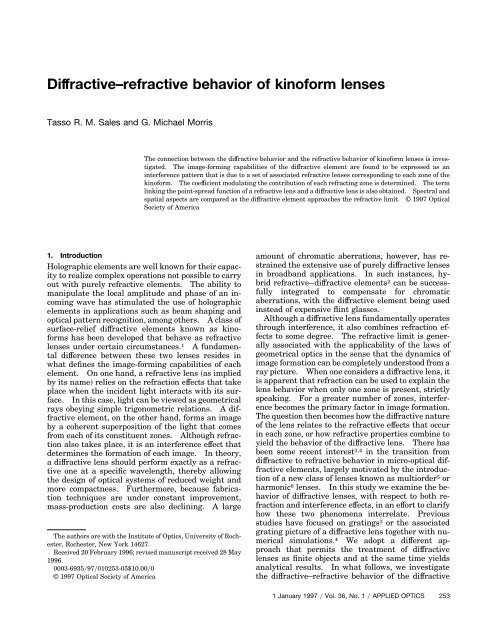Diffractive refractive behavior of kinoform lenses - Apollo Optical ...
Diffractive refractive behavior of kinoform lenses - Apollo Optical ...
Diffractive refractive behavior of kinoform lenses - Apollo Optical ...
Create successful ePaper yourself
Turn your PDF publications into a flip-book with our unique Google optimized e-Paper software.
where g n is a function <strong>of</strong> an integer argument. Themain reason for the generalization in Eqs. 5 willbecome clear in the following developments when the<strong>refractive</strong> role <strong>of</strong> each zone is made evident. In particular,we have the conventional, g n n, and thehigher-order, g n pn, cases for the usual diffractivelens designs.To elicit the diffractive–<strong>refractive</strong> relation, we developsome on-axis calculations based on the Fresnelapproximation to the diffraction integral 7 given by2 expikzz iz0r Nexpirexp iz r2rdr, (6)where we have made use <strong>of</strong> the circular symmetry <strong>of</strong>the elements under consideration and where r N is theboundary <strong>of</strong> the outermost zone or the semiaperture<strong>of</strong> the lens. Use <strong>of</strong> the phase function <strong>of</strong> Eqs. 5 inthe diffraction integral yields the following, somewhatformidable, expression for the on-axis scalarfield: D z 2 0fexpi2g n 0fz Nz n1 g n g n1 g n g n1 sinc 0fz g n g n1 , (7)where subscript D indicates a diffractive lens andirrelevant phase terms were ignored.By using Eq. 6 we can also determine the scalarfield <strong>of</strong> a purely <strong>refractive</strong> lens with maximum phaseheight 2 0 , given by R z 2 0fzexpi2 0 0fz 0 sinc 0f z 0 , (8)with index R indicating a <strong>refractive</strong> lens. We notethat Eqs. 7 and 8 can be combined because thesummation over zones in the diffractive scalar fieldcan be seen as a sum over the field caused by local<strong>refractive</strong> <strong>lenses</strong>. The result isN D z n1 expi2 0fn1g n g n1 R zg n z, (9)where n R is the phase function <strong>of</strong> a <strong>refractive</strong> lens <strong>of</strong>maximum phase height such that 0 g n g n1 .Because term g n g n1 is directly related to eachsingle zone, the diffractive element can be seen as theinterference <strong>of</strong> N <strong>refractive</strong> <strong>lenses</strong> whose characteristicsare determined locally by each zone. Noticethat this case is different from a lens array, which ismore akin to a grating in which each period may beconstituted by a <strong>refractive</strong> lens.The on-axis field that is due to each associated<strong>refractive</strong> lens is modulated by the complex interferenceterm, n l z expi2 0fn1g n g n1 , (10)zgwhich couples the <strong>refractive</strong> field amplitude <strong>of</strong> eachzone. The expression <strong>of</strong> the scalar field as in Eq. 9explicitly gives the contribution <strong>of</strong> each zone to formthe final interference pattern <strong>of</strong> the generalized diffractivelens. In the case <strong>of</strong> a higher-order lens wecan see thatg n g n1 pn pn 1 p, (11)implying that the <strong>refractive</strong> field associated witheach zone is independent <strong>of</strong> n and can be taken out <strong>of</strong>the summation. If we write n R z p R zto referto the higher-order lens, we can write Eq. 9 asN D z p R zn1 p expi2 0fzpn 1 p R zz, (12)where z represents the summation <strong>of</strong> phase termsover all zones and can be calculated exactly to bez Np expi 0fzN 1p sinc 0fzNpsinc 0 fzp .(13)It is also interesting to investigate how the pointspreadfunction PSF <strong>of</strong> the diffractive element relatesto that <strong>of</strong> the <strong>refractive</strong> lens. For this purpose,we consider a higher-order lens with maximum phaseheight 2p and N zones. Infinite conjugate imagingis assumed. The comparison to be carried outhere is with a <strong>refractive</strong> lens <strong>of</strong> maximum phaseheight 2Np and the same clear aperture as thekin<strong>of</strong>orm. After straightforward albeit somewhattedious calculations, which again are based on Eq.6, we find that the PSF <strong>of</strong> the diffractive lens, I D z,is written in terms <strong>of</strong> the PSF, I R z, <strong>of</strong> the <strong>refractive</strong>lens asI D z I T zI R z, (14)where term I T z relating the diffractive–<strong>refractive</strong>limits can be written ascosI T z 2 2 i1 0 fzpi1 cos 2 2 i1 0 fz p , (15)assuming that N 2 for an integer and i1 i 1 2... . Notice that in Eq. 14, term I R z correspondsto the purely <strong>refractive</strong> limit illustrated inFig. 1. At 0 the transition coefficient Eq. 15reduces to unity and the diffractive element behavesessentially as a <strong>refractive</strong> lens. This is expected becauseboth elements are identical at 0 , except for amodulo 2p transformation rule. However, for awavelength detuning from the design, the transitionterm becomes important and gives rise to those phenomenathat afflict a diffractive element such as re-1 January 1997 Vol. 36, No. 1 APPLIED OPTICS 255
Fig. 2. PSF’s illustrating the dispersive nature <strong>of</strong> a diffractivelens in comparison to a <strong>refractive</strong> one. The on-axis intensity isshown for three wavelength values: 0.5876 m index <strong>of</strong>refraction n D 1.5168 for BK-7 glass, 0.4861 m n F 1.5143, and 0.6563 m n C 1.5228. The diffractive lenswas designed to operate at 0 0.5876 m with a focal length <strong>of</strong>50 mm. In this case p 1 and N 32. The solid curve shows the<strong>behavior</strong> at the design wavelength, which is identical for bothdiffractive and <strong>refractive</strong> elements. Note the opposite sign <strong>of</strong> thedispersion and the appearance <strong>of</strong> multiple orders.Fig. 3. Evolution <strong>of</strong> the PSF <strong>of</strong> a diffractive lens <strong>of</strong> 32 zones andp 1 toward the <strong>refractive</strong> limit or N 1. Design parameters: 0 0.5876 m, F 50 mm, and 0.4861 m. For a meaningfulcomparison, product Np is set to a constant equal to 32.Note that as N decreases p increases the diffractive pattern tendsto approximate the spectral <strong>behavior</strong> <strong>of</strong> the <strong>refractive</strong> lens solidcurve. However, even for N 2 the spatial intensity pattern isconsiderably distinct from the <strong>refractive</strong> case.duced efficiency and the appearance <strong>of</strong> additionaldiffracted orders. These effects are illustrated inFig. 2 for what could be called a conventional diffractiveelement or p 1.From the PSF results derived above, we now investigatethe <strong>behavior</strong> <strong>of</strong> the diffractive lens as parameterp increases while Np remains fixed. Thiscorresponds to a sequence similar to the one depictedin Fig. 1. In performing the calculations previouslydescribed we have assumed an error-free diffractiveelement. Although this is not entirely realistic, inthe presence <strong>of</strong> small errors the results should still bevalid. Some discussion <strong>of</strong> fabrication errors with respectto the diffractive–<strong>refractive</strong> transition can befound elsewhere. 4In Fig. 3 the evolution <strong>of</strong> the point-spread functionas a function <strong>of</strong> the number <strong>of</strong> zones is presented.The <strong>behavior</strong> <strong>of</strong> the element can be analyzed from twoimportant aspects: spatial distribution and spectral<strong>behavior</strong>. These characteristics <strong>of</strong> the diffractionpattern are certainly related, but as the number <strong>of</strong>zones decreases and p increases, they need not evolvein a similar fashion. Indeed, we note in Fig. 3 thatas the diffractive lens tends to the <strong>refractive</strong> limit thediffractive point spread function tends to the corresponding<strong>refractive</strong> pattern. For instance, when thenumber <strong>of</strong> zones decreases from 32 to 16, the totalenergy on the first order is reduced while the secondorderfocal point undergoes an increase in efficiencyfollowed by a dislocation toward the paraxial <strong>refractive</strong>focal point. Such a process continues as N decreases,indicating that the diffractive element tendsto recover the <strong>refractive</strong> focal point for the wavelengthin question. Such clustering indicates that,spectrally, the tuning <strong>of</strong> parameter p in fact leads toa more <strong>refractive</strong>like diffractive lens, in accordancewith the idea that a higher order improves polychromatic<strong>behavior</strong>. 5,6 In contrast, the spatial characteristics<strong>of</strong> the point-spread function are also relevantbecause they reflect the efficiency <strong>of</strong> each diffractedorder and consequently provide important informationon image contrast. As we can see in Fig. 3, eventhough increasing p tends to reduce the contribution<strong>of</strong> spurious orders, it seems that the diffracted lensFig. 4. Transition term I T z, Eq. 15, as the diffractive elementtends to the <strong>refractive</strong> limit. The same design parameters <strong>of</strong> Fig.3 are adopted. In the purely <strong>refractive</strong> case, the transition coefficientis identically equal to one. As seen here, the basic dependencewith the number <strong>of</strong> zones remains essentially unaltered,except for a scaling term, up to N 2.256 APPLIED OPTICS Vol. 36, No. 1 1 January 1997
exhibits intensity pr<strong>of</strong>iles that are very peculiar up tothe case in which only two zones are present. In thisextreme limit, we might say that although parameterp tends to correct chromatic properties, it cannot correctthe spatial distribution <strong>of</strong> the produced beam.As a result, from the spatial point <strong>of</strong> view the kin<strong>of</strong>ormlens preserves its intrinsically diffractive naturewith any nonunity number <strong>of</strong> zones. Such a resulthas also been verified numerically in other designcases. 4 This fact can be made more evident in Fig. 4,where a plot <strong>of</strong> I T z, Eq. 15, is shown for distinctvalues <strong>of</strong> p. The basic dependence <strong>of</strong> the transitionterm, except for a scaling factor, is unaltered for allvalues <strong>of</strong> N.3. Summary and ConclusionsThe design <strong>of</strong> higher-order diffractive <strong>lenses</strong> poses theproblem <strong>of</strong> the diffractive–<strong>refractive</strong> <strong>behavior</strong> in certainkin<strong>of</strong>orm elements. We have expressed the onaxisscalar field <strong>of</strong> the diffractive lens in terms <strong>of</strong> aninterference pattern <strong>of</strong> associated <strong>refractive</strong> <strong>lenses</strong>related to each individual zone and modulated bya zone-dependent complex-valued coefficient. Althoughfor transverse fields the same idea shouldapply, it is not possible to obtain closed-form solutionsas in the on-axis case. We have found that it isalso possible to express the point-spread function <strong>of</strong>the diffractive lens as the product <strong>of</strong> a transition termand the intensity pattern <strong>of</strong> a <strong>refractive</strong> lens. In thisform, the connection diffractive–<strong>refractive</strong> is immediatelyestablished.Even though the <strong>refractive</strong> <strong>behavior</strong> becomes moreevident as the maximum phase height increases, thediffractive lens preserves a unique spatial identity upto the point at which only two zones are present buttends continuously to the <strong>refractive</strong> spectral <strong>behavior</strong>.This result has also been observed for gratingsby means <strong>of</strong> an altogether different method. 3 Although<strong>refractive</strong> elements without proper achromatizationmay be acceptable in some situations, fordiffractive <strong>lenses</strong> there is greater difficulty becausethe amount <strong>of</strong> chromatic aberrations is dramatic. Ifthe problem in question requires operation <strong>of</strong> a fewdiscrete wavelengths, higher-order diffractive <strong>lenses</strong>provide an elegant solution. As the number <strong>of</strong> zonesdecreases and higher values <strong>of</strong> maximum phase areattained, the diffractive <strong>behavior</strong> approaches that <strong>of</strong> a<strong>refractive</strong> lens but never completely reaches it; infact, for N 2 the spatial intensity pattern <strong>of</strong> the lensdeparts even more significantly from the <strong>refractive</strong><strong>behavior</strong>. Consequently, although intuitive, theconcept <strong>of</strong> a transition between diffractive <strong>behavior</strong>and <strong>refractive</strong> <strong>behavior</strong> does not evolve identically inthe spatial-spectral sense. In broadband applications,diffractive optics seem more promising for useas hybrid diffractive–<strong>refractive</strong> elements.This research was supported in part by the NewYork State Center for Electronic Imaging Systems.T. R. M. Sales is pleased to acknowledge financialsupport from the Brazilian agency Fundação Coordenaçãode Aperfeiçoamento de Pessoal de Nível Superior.References1. D. A. Buralli, G. M. Morris, and J. R. Rogers, “<strong>Optical</strong> performance<strong>of</strong> holographic kin<strong>of</strong>orms,” Appl. Opt. 28, 976–9831989.2. See, for example, D. Faklis and G. M. Morris, “<strong>Diffractive</strong> <strong>lenses</strong>in broadband optical system design,” Photon. Spectra 25, 131–134 1991.3. S. Sinzinger and M. Testorf, “Transition between diffractive and<strong>refractive</strong> micro-optical components,” Appl. Opt. 34, 5970–59761995.4. M. Rossi, R. E. Kunz, and H. P. Herzig, “Refractive and diffractiveproperties <strong>of</strong> planar micro-optical elements,” Appl. Opt. 34,5996–6007 1995.5. D. Faklis and G. M. Morris, “Spectral properties <strong>of</strong> multiorderdiffractive <strong>lenses</strong>,” Appl. Opt. 34, 2462–2468 1995.6. D. W. Sweeney and G. E. Sommargren, “Harmonic diffractivelens,” Appl. Opt. 34, 2469–2475 1995.7. J. W. Goodman, Introduction to Fourier Optics McGraw-Hill,New York, 1968.1 January 1997 Vol. 36, No. 1 APPLIED OPTICS 257



